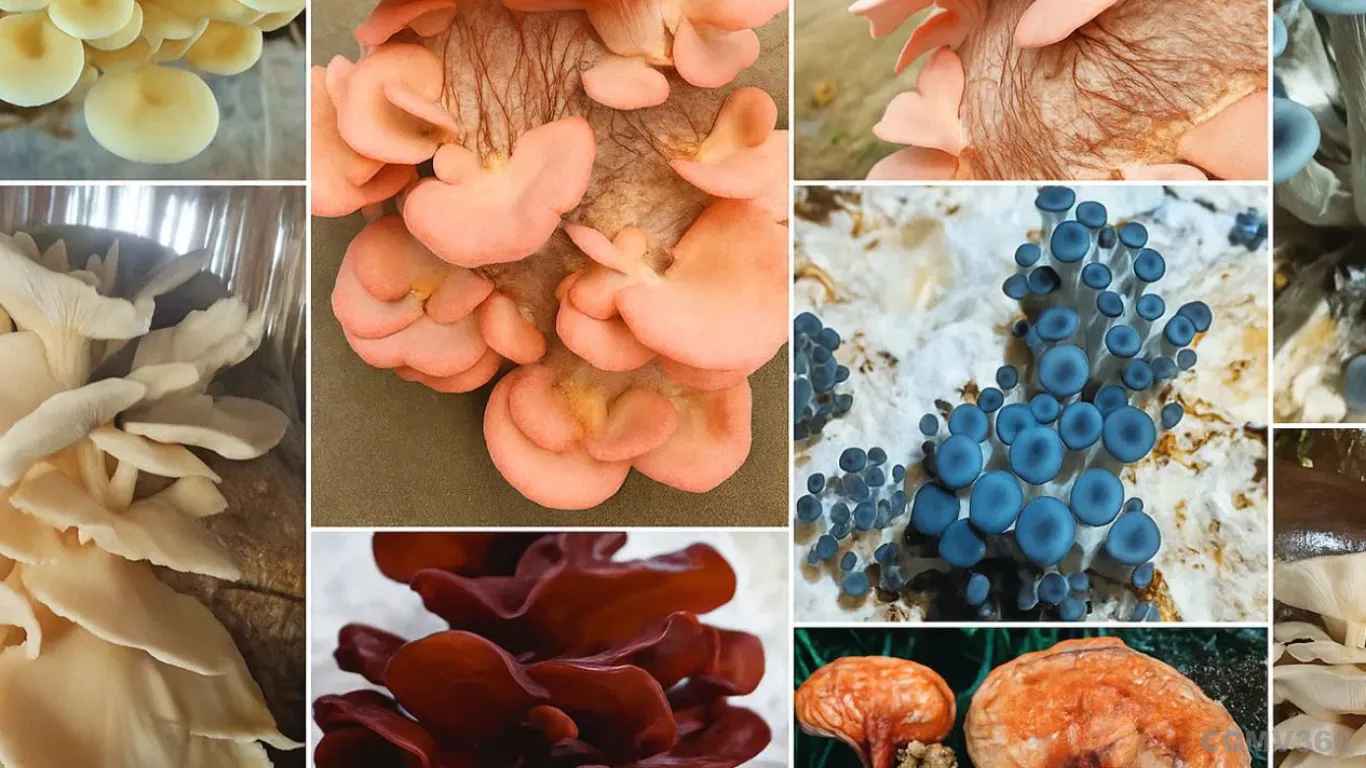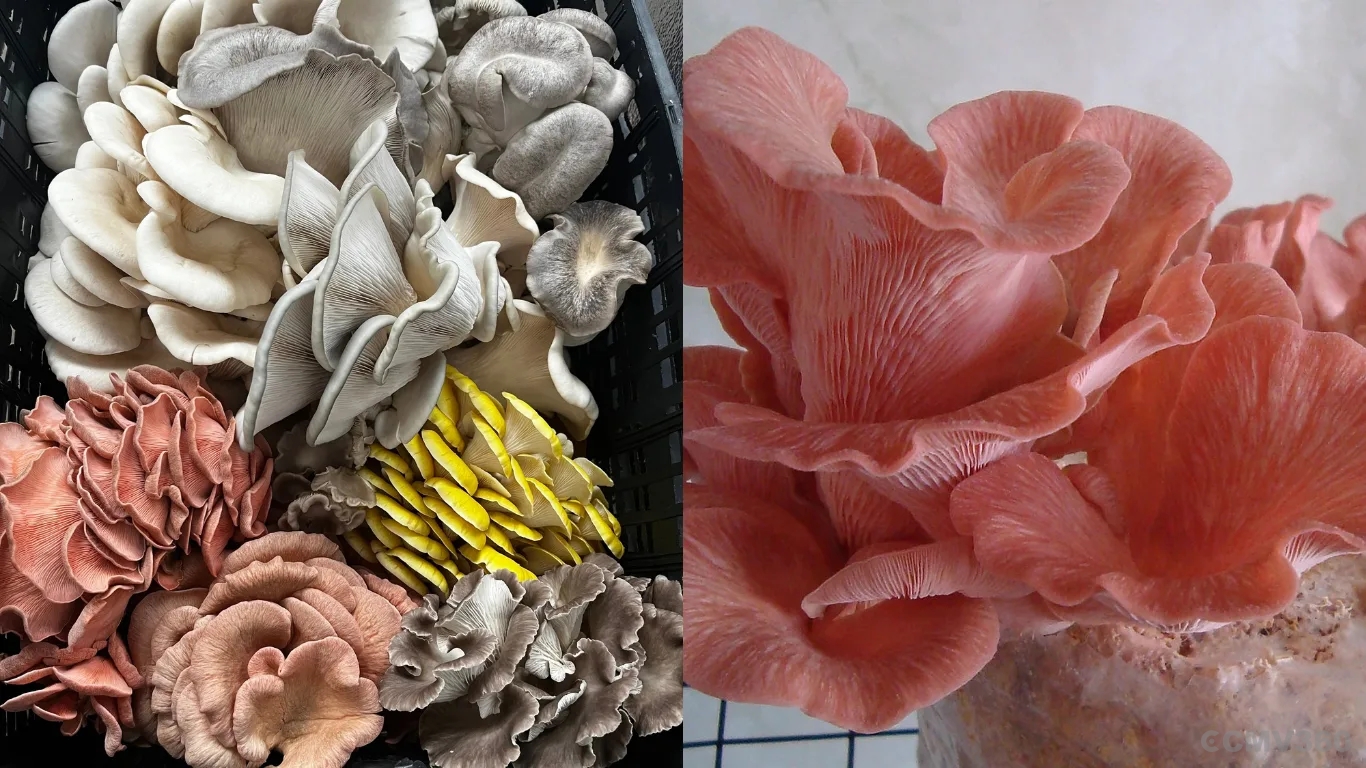Ad
Ad
Rainbow Mushroom Farming: Grow Colourful, Nutritious Mushrooms and Earn Big Profits

Rainbow mushroom farming is an exciting and eco-friendly way to cultivate naturally coloured edible fungi that are both nutritious and profitable. These beautiful mushrooms are rich in proteins, vitamins, and medicinal compounds, making them a premium product in the health-conscious and gourmet food market. Farmers across India are discovering that rainbow mushroom farming offers a sustainable, low-cost opportunity to increase income, use farm waste efficiently, and produce a high-value crop that appeals to modern consumers.
Also Read: Top 15 Powerful Superfoods to Boost Your Immunity and Stay Healthy
The Rise of Rainbow Mushroom Farming
Mushrooms have been part of human diets for centuries, valued for their rich taste, texture, and nutrition. In India, mushroom cultivation has gained huge popularity in recent years as a sustainable agricultural activity that requires less space and low investment while generating steady income.
Among all mushroom varieties, rainbow mushrooms stand out due to their natural colours, health benefits, and premium market value. Unlike regular white or oyster mushrooms, these fungi display beautiful shades of golden yellow, pink, blue, green, red, brown, and white. Each colour represents different nutrients and bioactive compounds that are beneficial for human health.
Rainbow mushrooms are not genetically modified. Their colours occur naturally, giving them an organic and eco-friendly appeal. The combination of eye-catching colours, strong nutrition, and medicinal properties makes them a perfect crop for small-scale farmers and agri-entrepreneurs.
Why Rainbow Mushrooms Are Special
Each type of rainbow mushroom offers something unique, from taste to health benefits. Here’s a look at some of the most popular varieties and their qualities:

1. Golden-Yellow Oyster Mushroom
Has a mild nutty flavour and soft texture.
Rich in antioxidants and vitamins.
Popular for stir-fries and soups.
Grows well in warm climates.
2. Pink Oyster Mushroom
Known for its bright pink colour and meaty texture.
Excellent source of protein and dietary fibre.
Ideal for frying, grilling, or sautéing.
It can be grown easily in hot and humid areas.
3. Blue Oyster Mushroom
Slightly stronger flavour compared to other oysters.
High in protein and minerals like potassium and zinc.
Has a long shelf life and is suitable for cool regions.
4. Green Russula Mushroom
Distinct nutty taste and crisp texture.
A favourite among gourmet chefs.
Known for its anti-inflammatory and antioxidant properties.
5. Red Reishi Mushroom
One of the most powerful medicinal mushrooms.
Used in making teas, powders, and supplements.
Helps improve immunity, reduce stress, and detoxify the body.
Commands very high market prices due to its health value.
6. Brown or Wood Ear Mushroom
Rich in fibre and iron.
Used widely in Asian cuisines, soups, and salads.
Has a crunchy, jelly-like texture.
These mushrooms are not only delicious but also packed with nutrients such as protein, vitamins (especially B and D), antioxidants, and essential minerals like selenium, potassium, and zinc. Their low-fat and high-fibre content makes them a perfect choice for today’s health-conscious population.
Benefits of Rainbow Mushroom Farming for Farmers
Rainbow mushroom farming offers multiple advantages, such as economic, environmental, and social. Here’s why farmers are increasingly turning towards this vibrant opportunity:
1. High Market Value: Rainbow mushrooms fetch better prices compared to regular white mushrooms. While traditional oyster mushrooms offer a profit margin of around ₹350 per kg, colored and medicinal varieties like Reishi can bring even higher returns. Restaurants, organic stores, and wellness brands are willing to pay more for their unique looks and nutritional quality.
2. Low Investment and High Returns: Mushrooms can be cultivated using agricultural waste materials such as wheat straw, rice husk, and sawdust. This means farmers can start with minimal capital and convert low-value waste into profitable produce.
3. Eco-Friendly and Sustainable: Since rainbow mushrooms grow on crop residues, they promote zero-waste farming and reduce pollution caused by burning stubble. This makes them a perfect example of sustainable agriculture.
4. Multiple Market Opportunities: These mushrooms have a wide range of uses:
Culinary: used in soups, curries, pizzas, and salads.
Medicinal: Reishi and similar types are used in capsules, powders, and teas.
Processed Products: mushrooms can be dried, pickled, or powdered for long shelf life.
5. Suitable for Small and Marginal Farmers: Mushroom farming doesn’t need large land areas. Farmers can grow rainbow mushrooms in small sheds, unused rooms, or even backyard spaces. This makes it a great option for unemployed youth, women entrepreneurs, and rural households.
Also Read: Useful Advice for Soybean Farmers: Right Sowing Time, Best Varieties, and Complete Cultivation Guide
Ideal Conditions for Growing Rainbow Mushrooms
Mushrooms need a controlled environment with the right temperature, humidity, and hygiene. The good news is that rainbow mushrooms can adapt to various climates, depending on the variety.
Mushroom Variety | Ideal Temperature | Suitable Regions |
Golden Yellow Oyster | 25–30°C | Warm and humid areas |
Pink Oyster | 25–32°C | Tropical regions |
Blue Oyster | 18–25°C | Cooler climates |
Green Russula | 20–25°C | Moderate climates |
Red Reishi | 25–30°C | Warm areas |
Wood Ear | 22–28°C | Humid regions |
Step-by-Step Process to Cultivate Rainbow Mushrooms
Rainbow mushroom cultivation is simple once the farmer learns the basic process. Here’s how it’s done:
Step 1: Spawn Selection
The process begins by purchasing good-quality mushroom spawn (seed material). Spawns should always be obtained from a reliable mushroom research centre or supplier.
Step 2: Substrate Preparation
A substrate is the growing base for mushrooms. Farmers can use:
Paddy straw
Wheat straw
Sawdust
Sugarcane bagasse
The substrate is chopped, soaked in water, and sterilized to remove harmful microbes. After cooling, it is mixed with mushroom spawn.
Step 3: Bag Preparation
The spawn-substrate mixture is filled into polythene bags and tied. Small holes are made for air circulation. These bags are placed in a dark, clean room with 80–90% humidity and temperatures between 20–30°C.
Step 4: Incubation Period
During the next 10–20 days, the white mycelium (fungal threads) spreads across the bag. This is called spawn running. Maintaining cleanliness and proper moisture is important to avoid contamination.
Step 5: Fruiting Stage
After mycelium growth, the bags are opened slightly or hung in a well-lit and humid area. Tiny mushrooms start appearing within 5–7 days. Regular spraying of water ensures steady humidity.
Step 6: Harvesting
When the mushroom caps open fully, they are ready for harvest. Mushrooms should be plucked gently without damaging the base. Harvested mushrooms are collected in baskets and can be sold fresh or processed.
Step 7: Post-Harvest Handling
Fresh mushrooms should be packed in perforated containers and kept in a cool place. For a longer shelf life, they can be dried, sun-cured, or turned into powder for use in soups, snacks, and medicines.
Cost and Profit Estimation
Rainbow mushroom farming gives excellent returns with minimal investment. Let’s take an example of oyster mushroom production:
Particular | Amount (₹ per kg) |
Cost of Production | ₹100 |
Selling Price | ₹450 |
Net Profit | ₹350 per kg |
Medicinal mushrooms like Reishi can fetch ₹800–₹1,200 per kg, though the yield is slightly lower. With continuous production, farmers can earn ₹30,000–₹60,000 per month, depending on scale, location, and variety grown.
Additionally, value-added products such as mushroom pickles, powders, soups, or health capsules can multiply profits even further.

Market Potential and Growing Demand
The global demand for mushrooms is increasing rapidly, driven by rising health awareness, vegetarian diets, and interest in organic food. In India, too, the mushroom industry is expanding fast, with rainbow mushrooms gaining special attention for their aesthetic and nutritional appeal.
Key Market Segments:
Hotels and Restaurants: High-end restaurants prefer exotic coloured mushrooms for gourmet dishes.
Health Food Stores: Sell rainbow mushrooms for their medicinal and nutritional benefits.
Pharmaceutical Companies: Buy Reishi and similar mushrooms for immunity-boosting supplements.
Export Market: Many countries import dried and powdered mushrooms from India due to their quality and organic certification.
Urban consumers are increasingly drawn to colourful, healthy food options, and rainbow mushrooms perfectly fit this demand. With proper marketing, branding, and packaging, farmers can tap into premium domestic and international markets.
Challenges in Rainbow Mushroom Farming
While profitable, mushroom farming requires attention and discipline. Some challenges include:
Temperature and Humidity Control: Extreme climate changes can affect yields.
Contamination: Fungal infections or pests can harm crops if hygiene is poor.
Short Shelf Life: Fresh mushrooms must be sold or dried quickly.
Market Awareness: Still limited in rural regions, though growing fast.
These challenges can be easily managed with proper training, clean practices, and small-scale infrastructure like humidifiers, sprayers, and cold storage.
Government Support and Training Programs
In India, several agricultural universities and departments promote mushroom cultivation through training and financial assistance. For example:
National Horticulture Board (NHB) and NABARD offer subsidies for setting up mushroom units.
Krishi Vigyan Kendras (KVKs) conduct hands-on training for beginners.
ICAR-Directorate of Mushroom Research (Solan, Himachal Pradesh) provides technical guidance and quality spawn materials.
Farmers can also apply for government schemes under Agri-Entrepreneurship and Agri-Startups to receive funding and business support.
Sustainable and Eco-Friendly Impact
Rainbow mushroom farming helps in waste recycling, carbon reduction, and soil health improvement. It allows farmers to earn money while protecting the environment. Since mushrooms grow from agricultural residues, this practice promotes circular farming, where waste from one crop becomes the raw material for another.
Moreover, mushroom compost left after harvesting is an excellent organic fertilizer, enriching soil for future crops and reducing dependence on chemical inputs.

Future of Rainbow Mushroom Farming in India
With rising demand for functional foods and natural health products, rainbow mushroom farming has a bright future. Experts predict that in the coming years, India could become a major supplier of exotic and medicinal mushrooms to international markets.
Technology such as automated mushroom houses, temperature control units, and online marketing platforms will make mushroom farming easier and more profitable. Young entrepreneurs, especially in rural areas, can build successful agribusinesses around these colourful fungi.
Value Addition and Business Expansion Ideas
To maximise profits, farmers can explore value-added products such as:
Mushroom Chips and Snacks – a healthy alternative to fried food.
Mushroom Soup Mixes and Powders – for instant cooking.
Medicinal Teas and Capsules – made from Reishi and other varieties.
Pickles and Sauces – unique homemade products for local markets.
Mushroom Cultivation Kits – for urban households and hobby growers.
By diversifying their product line, farmers can attract more customers and earn a steady income throughout the year.
Tips for Successful Rainbow Mushroom Farming
Always buy high-quality spawn from trusted sources.
Maintain clean and hygienic growing conditions.
Monitor temperature and humidity regularly.
Start small, learn the process, and then expand.
Focus on branding, packaging, and online marketing for better reach.
Attend training programs for technical knowledge.
Use farm waste efficiently to reduce production costs.
Also Read: International Day of Awareness of Food Loss and Waste 2025: Promoting Sustainable Food
CMV360 Says
Rainbow mushroom farming is more than just a business; it’s a smart, sustainable, and health-driven agricultural revolution. With its low investment, eco-friendly process, and high profit margins, it offers a golden opportunity for small and large farmers alike.
By producing colourful, nutrient-rich mushrooms, farmers not only earn better incomes but also contribute to a healthier society and a cleaner environment. As the demand for natural, organic, and medicinal foods continues to rise, rainbow mushrooms promise a vibrant future for those ready to embrace this colourful and profitable journey.
Features & Articles
Mastering Tractor Power: Complete Guide to Transmission System, Parts, Types & Functions for Smarter Farming
Learn about the tractor transmission system, its parts, types, and functions. Understand how clutches, gearboxes, and axles work together for better tractor performance....
03-Nov-25 12:33 PM
Read Full NewsInternational Day of Awareness of Food Loss and Waste 2025: Promoting Sustainable Food
Explore the importance of the International Day of Awareness of Food Loss and Waste 2025, its theme, impact, and solutions for building sustainable, efficient, and equita...
25-Sep-25 10:01 AM
Read Full NewsMore Work with Less Diesel: 7 Easy Tips to Increase Tractor Mileage and Save Farming Costs
Follow 7 simple tips to improve tractor mileage, save diesel, and lower farming costs. Learn about the top mileage tractors in India for 2025 and make farming more profit...
17-Sep-25 07:25 AM
Read Full NewsHow to Service a Tractor at Home: Top 5 Easy Tips for Farmers
Learn 5 easy tractor servicing tips at home to save money, improve engine performance, and extend tractor life. Simple steps for oil, filters, radiator, greasing, battery...
09-Sep-25 12:53 PM
Read Full NewsHidden Cost of Buying a Tractor in India Every Buyer Must Know About
Learn about tractor hidden costs like registration, insurance, implements, fuel, and maintenance to plan your budget smartly and avoid unexpected expenses....
12-Aug-25 01:22 PM
Read Full NewsHow to Save Your Tractor Clutch from Early Damage: Easy Tips for Long Life and Smooth Farming
Prevent early clutch failure in tractors with easy maintenance tips and daily checks for better performance and longer life....
04-Aug-25 11:59 AM
Read Full NewsAd
Ad
As featured on:


Registered Office Address
Delente Technologies Pvt. Ltd.
M3M Cosmopolitan, 12th Cosmopolitan,
Golf Course Ext Rd, Sector 66, Gurugram, Haryana
pincode - 122002




















